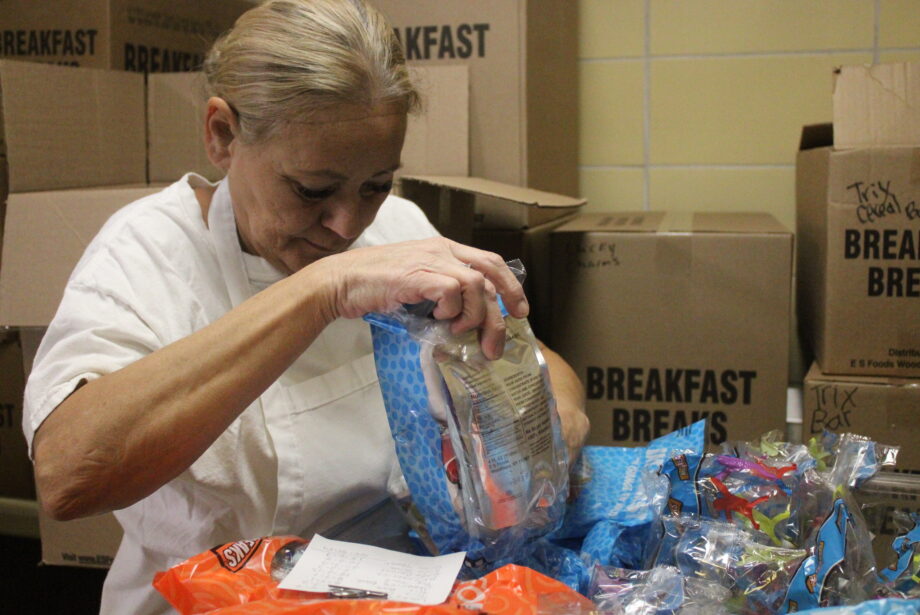George Houlton arrives to work in the kitchen of Burlington High School earlier than usual on spaghetti days.
By 5 a.m., the long-time kitchen manager will begin dropping about 170 pounds of beef into the kitchen’s industrial-grade kettle.
It’s meals like these that he and his kitchen staff enjoy preparing the most.
“When you do the kettle, you can put a little bit of love into it,” Houlton said on a recent February morning. “The funny thing is, everybody’s got a family recipe for these kinds of things — tacos, nachos, deviled eggs, spaghetti — but we have to stay within what they tell us.”
Houlton was referring to nutrition standards enacted by the U.S. Department of Agriculture. These standards grew more stringent under the Healthy, Hunger-Free Kids Act enacted in 2010. The legislation made school meals healthier by reducing sodium, saturated fats, and trans fats, but it also left schools somewhat limited in how creative they can get with their meals.
“When the Obama Administration came in, they wanted more vegetables and stuff, so what they did was, they increased fruits and vegetables in size, so you really can’t get enough vegetable and fruit in the eyes of school nutrition. You have to watch sodium, you have to watch sugar levels. That’s why the options are limited and repetitive.”
Such changes left the BHS kitchen staff struggling to find a way to continue to provide the same foods and tastes with which their students had grown accustomed.
Houlton recalled a time when the district had ordered chicken strips with whole-grain breading in response to a whole-grain requirement. Both students and kitchen staff were less than enthused about the new product.
“It was terrible. The breading, it was like chewing on paper towel or cardboard,” Houlton said. “The kids were eating this thing that they used to eat. Now there’s no trust. It’s the worst thing that can happen to a food item.”
By adjusting other food items served with the chicken strips, they were able to find some that more closely resembled the ones that students had come to know and love, but it took time for students to give them a chance.
In school, things are constantly changing: friends, classes, personalities, you name it, but Houlton believes the one constant should be food.
“It’s stability,” Houlton said. “At the high school, one day you’re country, the next day you’re a sports star, the next day you’re a grunge or whatever you want to be. The only stability is meals.”
When schools throughout Iowa closed in March 2020 due to the pandemic, the district’s food service workers continued to show up at their respective posts to prepare meals for curbside service.
When schools resumed in-person learning, those same workers adapted quickly to supply chain issues, one time subbing in sausages for hotdogs, and staffing shortages, replacing hot breakfasts with pre-packaged ones, but still there was food — and a whole lot of it.
The BHS kitchen serves as the food hub for the entire district, and between 1,800 and 2,100 lunches pass through it each day.
Keeping much of it in order is Kelly Pfeifer, who oversees satellite operations.
“I’m responsible for all the food to go out to the six schools, the four elementary and the intermediate and middle schools,” Pfeifer said.
That includes sending out modified meals for students with allergies, food sensitivities, and health conditions such as diabetes.
Pfeifer has been in her current position for three years but joined the district nine years ago as a food service substitute before becoming a server at Sunnyside Elementary School.
“It was great for my family,” Pfiefer said, explaining the position allowed her to get to know her kids’ friends and teachers.
She also enjoyed interacting with students.
“When I worked in the elementaries, I loved the little kids,” she said. “They were so cute.”
Marvalene Cousins, a general cook, is in her 32nd year in the district. Each day, she prepares three types of sandwiches and looks forward to interacting with the students who come through her line.
“I like the people, the kids, just having a good time,” she said. “We’ll make small talk with them, ask them how they are, how their weekend was. You can get some ornery ones, and you just have to talk back. The next day, they’re sweet as can be.”
Vegetable cook Dottie Huss began working in the high school 30 years ago, following in the footsteps of her aunt, who worked in school food service for more than a decade.
“I get along with the kids real well,” Huss said.
There are a total of 13 kitchen staff at BHS, and Houlton said each plays a vital role in operations.
“The crew that I have, they’re on top of it,” Houlton said. “This is the best that it gets for school food service, There’s a lot of thought and care in it.”





